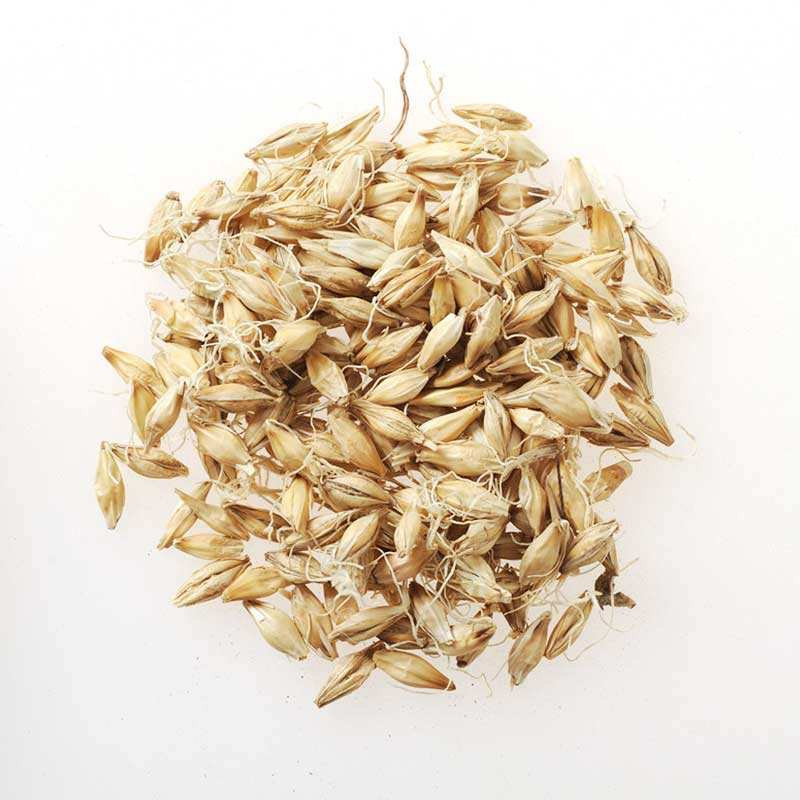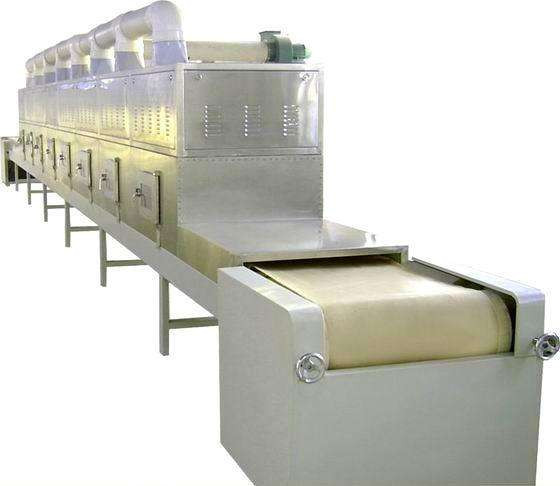Effect of microwave drying on malt quality

The microwave drying equipment was applied in malt drying and sterilization. The characteristics of microwave drying and the changes of several main enzymes in malt drying were preliminarily explored. The optimum microwave drying technology was tried to replace traditional oven drying technology, and a time-saving and energy-saving microwave drying technology was explored. The experimental results show that the two microwave processes adopted in this experiment save 80.38% and 83.08% of the time compared with the traditional ones, respectively. It can be seen that the microwave process has the advantage of saving time.
Beer is the lowest alcoholic beverage. Because of its rich nutrition and cheap and good quality, it has been favored by more and more consumers. Especially in developing countries, beer production has been developing rapidly, which has led to the sustained growth of beer production worldwide. The development of malting technology will certainly play a great role in promoting the development of beer industry.

At present, the main drying technology in wheat processing is hot air drying. When traditional hot air drying methods are used to dry different raw materials, the heating inside and outside of raw materials is uneven, energy consumption is high, time is long and the drying effect is unsatisfactory. Microwave drying equipment has been studied and applied in many fields, such as food, medicine and food. Microwave technology has been developing in China for nearly 30 years. Although it is still a new application field, with the continuous progress of modern science and technology, the reliability and practicability of microwave equipment are constantly improving.
1.
Test material and square hair
Australian wheat Gairdner, coffees malt.
Reagent:
Potassium iodide, 3,5-Dinitrosalicylic acid glycerol, soluble starch, sulfuric acid (concentrated), hydrochloric acid, glacial acetic acid, sodium acetate hydrate, trichloroacetic acid, hydroquinone, catechol, citric acid, sodium citrate, sodium dihydrogen phosphate, disodium hydrogen phosphate, anhydrous sodium carbonate, sodium hydroxide, xylan and hydroxymethyl Cellulose sodium and other reagents are all analytically pure.
Instrument:
Granz WP800TL-23 microwave oven; SHP-150 biochemical incubator; YQ-PJ-6B automatic saccharifier; HH constant temperature water bath pot; standard EBC malt crusher; non-contact infrared thermometer AR300, Higma instrument; YP402N electronic balance; JPT-5 tray balance; 701-type electric heating dryer; WFJ7200 visible light fraction Spectrophotometer; GTL16A high speed centrifuge; TG328A electro-optic analytical balance.
Malt preparation:
Weighing 300 g Gairdner barley, after washing, soaking the barley, the liquid level should exceed 10 cm of barley, and culture at 16 C. Soak wheat: soak 5h, cut water 10.5h, soak 5.5h and water 3H. A total of 24h. Germination: during the period of 96h, at least 3 times per day, at night, and 42% degree of soaking.
Microwave drying equipment for malt:
The drying stage can be divided into the following stages: the first stage (moisture removal), with the temperature controlled between 40 and 50 degrees C, heating for 2 minutes and intermittent for 4 minutes. The water is reduced to below 30%, completing the first stage. In the second stage (drying), the temperature is controlled at about 60 C, heating 5min and 2min intermittently. The water is reduced to below 10%, and the second stage is completed. The third stage (high temperature baking). The temperature is controlled at about 70 C, heated for 50 seconds, intermittent for 2 minutes (group 2 for microwave process 1); and the temperature is controlled at about 80 C, heated for 50 seconds, intermittent for 2 minutes (group 3 for microwave process 2). The water is reduced to below 5%, and the third stage is completed. After the three stages were completed, the water content of malt reached the required standard. At this time, the samples were taken and the enzyme activity was determined to determine the drying end point. The first stage of traditional malt drying (group 1) was (tidal discharge): 55 3H 1h; the second stage was (drying): 60 3H 1H 67 10h; and the third stage was (roasting): 65 75 1H 83 4;5h.
Determination of malt moisture content:
According to national standard GB 50093-2010 implementation.
Preparation of enzyme solution:
The 10g dried malt is called, and the water on the surface of the malt is dried with filter paper. Put the malt into the grinder (rinse with deionized water before using the grinder and dry in the oven) and grind it. Then the crushed malt was put into the saccharifying cup, 90 mL deionized water was added, and 10 mL was buffered by acetic acid-sodium acetate with a pH value of 5.0. The malt was heated and stirred for 1 hour in a water bath at 40 ~C. Centrifuge 15min with centrifugal force of 2400 * g was centrifuged. Finally, the supernatant was used to determine enzyme activity. In this process, all containers are rinsed with deionized water for 3 times.
Determination of enzyme activity of malt main enzymes:
Alpha amylase, beta amylase, xylanase and cellulase activity were determined by DNS colorimetric method.
Changes in moisture content of malt during drying:
The first stage of drying: the moisture content is below 30%, that is to say, to the 10th group of samples, this point can be set as the end point of the first stage of drying, when the first stage of drying time is 120 minutes; the second stage of drying: the moisture content is below 10%, that is to say, to the 7th group of samples, this point can be set as the end point of the second stage of drying, when the second stage of drying. The third stage of drying: the moisture content is less than 5%, i.e. group 2 to group 12. The third stage of drying is 68 minutes; group 3 to group 17, this point can be set as group 3, group 3, the third stage of drying is 96 minutes and 2 seconds. Group 2 and group 3 were sampled from the above provisional drying end points, and one sample was taken every two cycles, i.e. every 5 minutes and 40 seconds. Each group took 8 samples, and the corresponding enzyme activities were determined, and the curves were compared.
Changes in activity of alpha amylase:
After water reached the required standard, the activity of alpha-amylase in group 2 malt decreased slowly during the continuous drying process. This is because in the late drying stage, the moisture content decreases, the temperature continues to rise, but the range of change is low, and the enzyme continues to inactivate slowly.
After water reached the required standard, the activity of alpha-amylase in malt of group 3 decreased rapidly in the first four groups. This is because in the early stage of the third stage, the water content is higher than that in the later stage, which leads to the rapid decrease of enzyme activity. After that, the activity of alpha-amylase in the four groups decreased slowly, which was due to the decrease of water content, the increase of temperature, the decrease of change range and the slow inactivation of the enzyme in the later drying stage.
The activities of beta amylase in malt of group 2 and group 3 were gradually decreasing.
Changes of xylanase activity: In group 2, the xylanase activity in malt decreased first and then increased. In the first four groups, xylanase activity decreased slightly, but increased significantly from the 5th group to the 8th group. The reason may be due to the higher water content in the previous groups. With the increase of temperature, the activity of enzyme decreases rapidly, and with the rapid decrease of water in the later period, the activity of xylanase in malt of unit mass keeps basically unchanged, and the activity of xylanase becomes higher.
Group 3 maltose xylanase is generally a process of first falling and then rising. In the first four groups, xylanase activity decreased slightly, but increased from the 5th group to the 8th group, and the final activity was similar to the original.
Cellulase activity in group 2 malt decreased slowly, and the rate of decline remained unchanged. This may be due to the fact that the activity of cellulase has been reduced to a certain extent during the final high-temperature coking process, and basically remains unchanged.
In group 3, the cellulase in malt is a decreasing process in general. The decline rate is faster than that of group 2. The reason may be that this group of coke has a higher baking temperature, so the decline rate is faster.
Comparison of the time required for microwave drying and traditional drying methods:
Considering the two aspects of heat consumption and time, the shorter the drying time, the less energy consumption. So the two drying points choose the time of the first sample. The total drying time of group 2 was 306 minutes, while that of group 3 was 266.33 minutes. The total drying time of group 2 was 306 minutes, and that of group 3 was 266.33 minutes. The time required for traditional drying methods is 26h. It is obvious that the microwave drying method has a faster speed and saves a lot of time. The microwave drying time of group 2 is 80.38% and that of group 3 is 83.08%.
The activity of alpha amylase ranged from high to low: group 2, group 3 and group 1. Group 2 increased the activity of alpha amylase by 40.6% compared with the traditional drying method. Group 3 increased the activity of alpha amylase by 1.2% compared with the traditional drying method.
The activity of beta amylase ranged from high to low: group 3, group 2 and group 1. Group 2 increased the activity of beta amylase by 19.7% compared with the traditional drying prescription. Group 3 increased the activity of beta amylase by 70% compared with the traditional drying method.
Xylanase activity ranged from high to low: group 2, group 3 and group 1. Group 2 increased the activity of xylanase by 45.2% compared with the traditional drying prescription. Group 3 increased the xylanase activity by 9.7% compared with the traditional drying method.
Cellulase activity ranged from high to low: group 2, group 3 and group 1. Group 2 increased cellulase activity by 37% compared with the traditional drying method. Group 3 increased cellulase activity by 4.6% compared with the traditional drying method.
Two. Conclusion
In this paper, microwave drying of malt was preliminarily studied, trying to explore a suitable microwave drying process for malt, and to detect the changes of water content and the activities of several important enzymes. The conclusions are as follows:
(1) it is obvious that microwave drying is faster and saves a lot of time. Compared with the traditional drying method, group 2 microwave drying process saves time.
80.38%, group 3 microwave drying process time saved 83.08%.
(2) The effects of microwave drying on alpha-amylase, beta-amylase, xylanase and cellulase in malt are different. Among them, the drying process of group 2 significantly increased the activities of alpha-amylase, xylanase and cellulase, while the drying process of group 3 only significantly increased the activity of beta-amylase.
Generally speaking, the two drying processes have a certain effect on improving the activity of each enzyme, group 2 is more significant, group 3 is slightly worse.